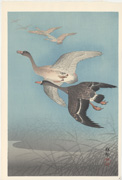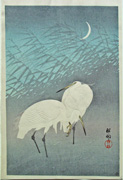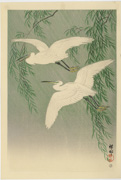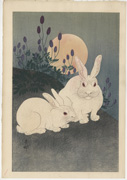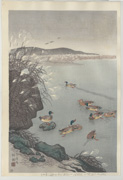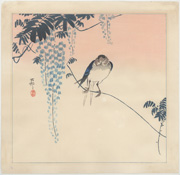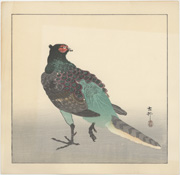Prints in Collection
Starlings in Flight, c. 1910 IHL Cat. #38 | Sparrow Feeding an Insect to its Chick, c. 1905/1926 IHL Cat. #2281 | Barn Swallow on Branch of a Flowering Weeping Cherry Tree, c. 1905/1926 IHL Cat. #2282 |
Wild Geese, c. 1946/1957
(originally 1926)
IHL Cat. #13
Herons in Reeds, c. 1946/1957
(originally 1926)
IHL Cat. #15
(originally 1926) IHL Cat. #1912 | Rabbits with Bush Clover Under Full Moon, c. 1930 IHL Cat. #73 | IHL Cat. #1766 |
Swallow and Wisteria,
1921/1939
IHL Cat. #14
Pheasant,
1921/1939
IHL Cat. #16
Small Prints
Peacock and Cherry Blossom, 1930/1936
IHL Cat. #1537
Eagle Perched on a Cliff, unknown date
IHL Cat. #2239
-intentionally left blank-
Biographical Data
Profile
Ohara Koson 小原古邨 (1877-1945)Source: Art of the Print website www.artoftheprint.com/artistpages/koson_ohara_shoson_canaryandroses.htm
Ohara Koson was the most famous shin hanga designer of bird and flower prints (kacho-e). He created prints under three different artist names (gō)- Ohara Hōson 小原豊邨, Ohara Shōson 小原祥邨 and Ohara Koson. While he worked for a number of publishers, his most famous association was with the publisher Watanabe Shōzaburō (1885-1962).
Koson is acknowledged as a master of twentieth-century printed kachoga,and with some 500 prints to his name, he was one of the most, if notthe most, prolific kachoga artists.
Koson's prints were designed for Western tastes and were exported to the United States and Europe where they met with great success. His work has only recently received attention in hisnative Japan following the discovery of important reference materialincluding original sketches and paintings for his prints.
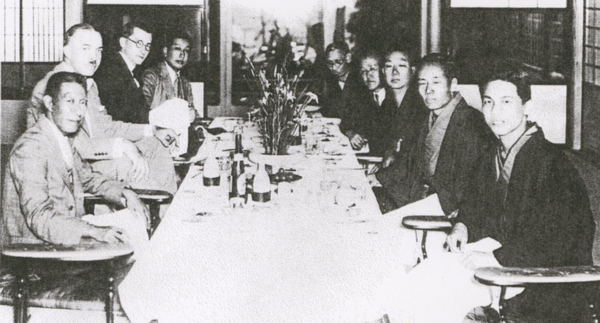
1934 group photo with Ohara Koson the figure at the back on the right. The artist Okada Saburosuke (1869-1939) is first figure on left, with Watanabe Tadas pictured first on right, followed by his father Watanabe Shōzaburō (1885-1962) and the artists Ito Shinsui and Kawase Hasui (1883-1957). (Scanned from "Crows, Cranes & Camellias," Fig. 23, p. 25.)
Biography
Ohara Koson (1877-1945)Sources: Printed to Perfection – Twentieth-century Japanese Prints from the Robert O. Muller Collection, Joan B. Mirviss, et. al., Smithsonian Institution and Hotei Publishing, 2004, p. 50; Crows, Cranes & Camellias. The NaturalWorld of Ohara Koson 1877-1945. Japanese Prints from the Jan PerreeCollection, Amy Reigle Newland, Jan Perree & RobertSchaap, Amsterdam Rijksmuseum, Amsterdam, 2001, p. 9-29.
| Little is definitively known about the artist's life. He was born Ohara Matao in Kanazawa, Ishikawa Prefecture in the north of Japan. It is thought that he attended the Ishikawa Prefecture Technical School from 1889-93 where he learned painting and design and that he studied with the painter Suzuki Kason (1860-1908) either while there or after he moved to Tokyo. It is likely that he received his gō (artist’s name) Koson from Kason. Around 1900 he became a teacher at the Tokyo Bijutsu Gakko (Tokyo School of Fine Arts), where he is said to have met the American Ernest Fenollosa (1853-1908), then a professor at the Tokyo Teikoku Daigaku (Tokyo Imperial University; present-day University of Tokyo) and an advocate of traditional Japanese arts. Under Fenollosa's encouragement Koson began producing kacho-e (bird and flower) prints and exhibiting his paintings and woodcuts in the United States.1 |
In 1912 Koson changed his artist’s name to Shōson. For approximately thenext fourteen years he dedicated himself primarily to painting, until his relationship with the publisher Watanabe Shōzaburō (1885-1962) solidified in 1926.
In addition to kacho-e he designed several prints of the Russo-Japanese War (1904-1905) for the publisher Kanatado Heizo and a number of landscape prints.
Publishers
Source: Printed to Perfection – Twentieth-century JapanesePrints from the Robert O. Muller Collection, Joan B. Mirviss, et. al.,Smithsonian Institution and Hotei Publishing, 2004, p. 50 and an internet posting of May 24, 2000 by Jan Perrée (whose collection formed the basis of the catalogue raisonne.)Note: for a detailed explanation of Shōson's publishers Daikokuya and Kokkeido see Crows, Cranes & Camellias p. 18-21 (op. cit.)
Most of his earlier woodcuts (c. 1904-05) were published in Tokyo by Daikokuya2 (Matsuki Heikichi) and Kokkeido (Akiyama Buemon). In 1926 he began working with the publisher Watanabe Shōzaburō (1885-1962) who, as a result of the devastating Great Kanto Earthquake of 1 September 1923, was looking for new print artists like Koson to rebuild his business. Koson signed his prints issued by Watanabe with the name Shōson. He worked for Watanabe until about 1935. In the early 1930s, Koson also made prints with the publisher Sakai/Kawaguchi and signed them Hōson. After about 1935 he worked under the name "Shōson" probably for Nishinomiya Yosaku, a small publisher in Tokyo who worked from around 1900 till the end of World War II.3
Koson’s prints can perhaps be best characterized as “printedpaintings.” Particularly in his early work with the publisher Daikokuya (MatsukiHeikichi), blockcutters and printers convincingly transmitted thepainterly feel of his works to the print medium. His work with Watanabeassumes a more graphic and less painterly feel then his earlierpublishers, Kokkeido and Daikokuya.
Shōson's prints were displayed at both the 1930 (21 prints) and 1936 (33 prints)Toledo Museum of Art exhibitions of shin-hanga prints.
Profile of Artist from Watanabe Shōzaburō's Catalogue of Wood-Cut Colour Prints, 1936
Most of his earlier woodcuts (c. 1904-05) were published in Tokyo by Daikokuya2 (Matsuki Heikichi) and Kokkeido (Akiyama Buemon). In 1926 he began working with the publisher Watanabe Shōzaburō (1885-1962) who, as a result of the devastating Great Kanto Earthquake of 1 September 1923, was looking for new print artists like Koson to rebuild his business. Koson signed his prints issued by Watanabe with the name Shōson. He worked for Watanabe until about 1935. In the early 1930s, Koson also made prints with the publisher Sakai/Kawaguchi and signed them Hōson. After about 1935 he worked under the name "Shōson" probably for Nishinomiya Yosaku, a small publisher in Tokyo who worked from around 1900 till the end of World War II.3
Koson’s prints can perhaps be best characterized as “printedpaintings.” Particularly in his early work with the publisher Daikokuya (MatsukiHeikichi), blockcutters and printers convincingly transmitted thepainterly feel of his works to the print medium. His work with Watanabeassumes a more graphic and less painterly feel then his earlierpublishers, Kokkeido and Daikokuya.
Shōson's prints were displayed at both the 1930 (21 prints) and 1936 (33 prints)Toledo Museum of Art exhibitions of shin-hanga prints.
Profile of Artist from Watanabe Shōzaburō's Catalogue of Wood-Cut Colour Prints, 1936
Note: To view the entire catalogue go to Catalogue of Wood-Cut Colour Prints of S. Watanabe, 1936
Mr. Ohara whose surname is Matao, was born at Kanazawa, Kaga Province, on February 9th, 1877. He came up to the capital where he studied painting under Suzuki Kason. Then he painted a good many flowers and birds under the guidance of Mr. Fenellosa, an American, who was a professor of the Tokyo Art School (At first a professor of the Tokyo Imperial University) and an adviser to the Imperial Museum. According to the order of Daihei Picture Shop, Ryōgoku, he had made designs for colour-prints depicting flowers and birds under the name of "Koson." In 1912, he changed his name to Shōson and had engaged in producing original paintings. But since 1926 he is trying his best for the Watanabe Colour-prints Shop in drawing mostly flowers and birds, which are his specialty. There was hardly an expert in flowers and birds among the Ukiyoe artists of olden times, so that the superior works are not found much. Shōson's grass, flowers, birds and animals are drawn, being based upon enthusiastic sketching. Further they are beautified as much as possible. Therefore they are the colour-prints well fit for a household decoration that keeps for a long time.
Designs for the Western Market
Source: John Fiorillo’s website Viewing Japanese Prints http://www.viewingjapaneseprints.net/texts/shinhangatexts/shinhanga_pages/shoson3.htmlThe subject matter and style of Shōson's prints appealed to the Western market and thus much of his work was intended for export. His compositional style and marketing significantly affected how his works were viewed in Japan, for he was considered an artist somewhat outside the circle of those who designed prints for the home market and the Japanese taste.
There was little interestin his work in Japan until many years later, c. 1970, when Japanesescholars and collectors began recognizing the genius of this greatartist.
Promo for Catalogue Raisonee "Crows, Cranes and Camellias: The Natural World of Ohara Koson, 1877-1945"
Source: http://www.japaneseprintsandbooks.com/shoson.htmlLittle is known about the artist Ohara Koson (1877-1945), whose career bridged the era between the decline of the full-color woodblock print (nishiki-e) in the late 19th century/early 20th century and the emergence of the Shin-hanga ("new print") movement in the 1910s. An artist principally marketed abroad, Koson’s bird-and-flower prints met with great success in the United States and Europe. He has only recently received attention in his native Japan following the discovery of important reference material including original sketches and paintings for his prints.
The work of print artist Ohara Koson (1877-1945) mainly consists of prints of birds and flowers, characterized by their peaceful charm. This book about Koson is the first Western publication of his oeuvre of prints and paintings. It provides all known information on the artist's life and work, his teachers and publishers, facsimiles of his signatures and seals and illustrations of an estimated seventy-five percent of his total print output.
1 Amy Reigle Newland in Crows, Cranes & Camellias (op cit.) casts doubt on the association with Fenollosa - "...he may have well known Fenollosa. But the nature and extent of this relationship, if it existed is unclear."
2 There is some confusion about Daikokuya's role in publishing Koson prints in the 1930s and 40s, after ownership of the publishing house transferred from the Matsuki family to S. Koizumi.
3 According to Newland in Crows, Cranes & Camellias, "it seems that the Nishinomiya prints date to sometime later, perhaps after WWII, and were pulled from older blocks." (op. cit.)
Artist's Signatures and Seals
The New Wave: Twentieth-century Japanese prints fromthe Robert O. Muller Collection, Amy Reigle Stephens, BambooPublishing Ltd, London & Hotei-Japanese Prints, Leiden, 1993
3 According to Newland in Crows, Cranes & Camellias, "it seems that the Nishinomiya prints date to sometime later, perhaps after WWII, and were pulled from older blocks." (op. cit.)
Artist's Signatures and Seals
 Hōson 豊邨 Signature: Hōson Seal: Hōson Seal used on prints published by Kawaguchi & Sakai | 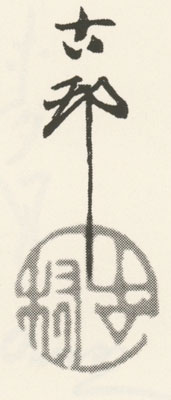 Signature: Koson Seal: Koson |  Signature: Koson Seal: Koson | 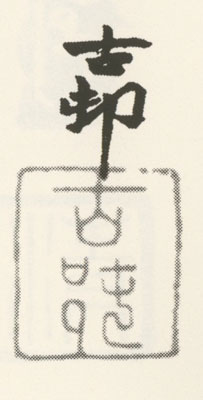 Koson 古邨 Koson 古邨Signature: Koson Seal: Koson | 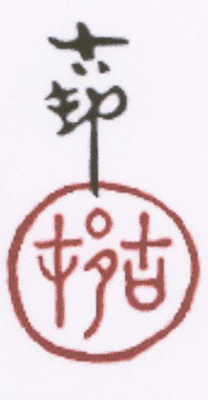 Koson 古邨 Koson 古邨Signature: Koson Seal: Koson |
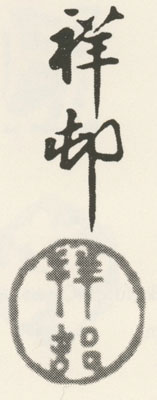 Signature: Shōson Seal: Shōson Seal used on prints published by Watanabe Shōzaburō | 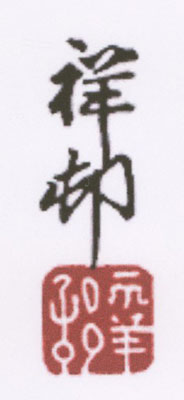 Signature: Shōson Seal: Shōson Seal used on prints published by Watanabe Shōzaburō |  |
Literature
Catalogue Raisonne: Koson Ohara - Amsterdam Rijksmuseum, Crows, Cranes & Camellias. The Natural World of Ohara Koson 1877-1945. Japanese Prints from the Jan Perree Collection, Catalogue, Amy Reigle Newland, Jan Perree & Robert Schaap. Amsterdam 2001The New Wave: Twentieth-century Japanese prints fromthe Robert O. Muller Collection, Amy Reigle Stephens, BambooPublishing Ltd, London & Hotei-Japanese Prints, Leiden, 1993



